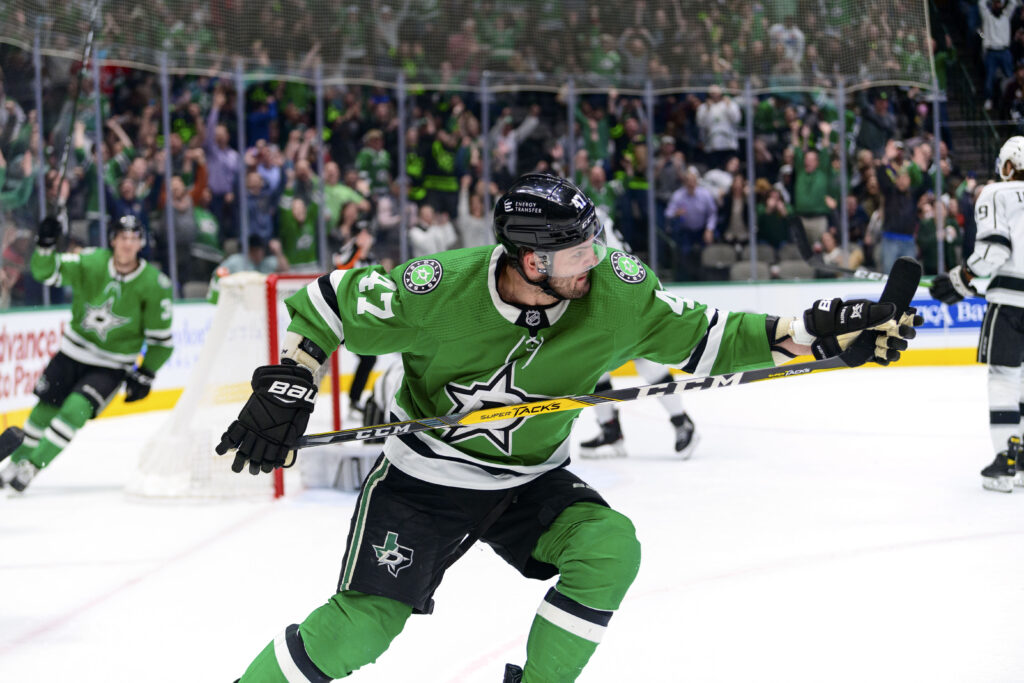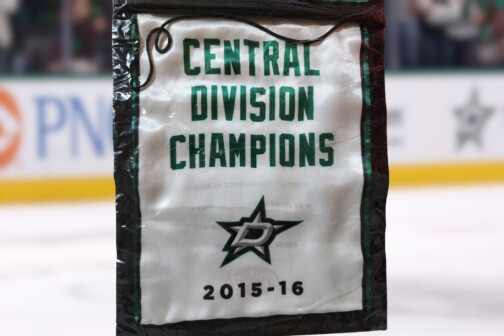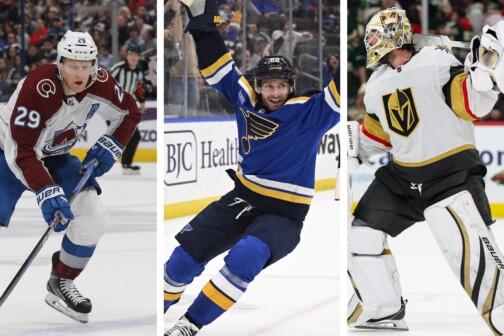The Stars’ trajectory remains unknown, but we can at least say with certainty when things changed. On Thursday, the Stars received bad news. Miro Heiskanen will be out indefinitely after being diagnosed with mononucleosis. According to Johns Hopkins Medicine, mono can last for one to two months, which means Dallas is in the dark about whether Heiskanen returns before the playoffs (presuming the Stars make it). The good news is that, one day later, they signed Joe Pavelski to a one-year, $5.5 million extension. And in neutral news, Jeff Marek reported on Saturday that John Klingberg is off the market.
Now what?
On the surface, this sets up a quiet trade deadline for Jim Nill. The Stars don’t have the cap space to add someone, and their most tradeable contracts are pieces needed to keep the team’s head above water. There isn’t a market for the contracts they can trade, like Anton Khudobin’s, and even then Dallas would ideally only move the players on them for a difference-maker. But with Heiskanen out, there’s no guarantee that the right trade would make a huge impact on their playoff push in the first place. Stop me if you’ve heard this one before: the Stars are once again stuck in no man’s land.
Or are they? I hate to get into the weeds of the hockey market, but let’s start with the cap problem. Arizona Coyotes GM Bill Armstrong said it best when asked about the problem with the market. “Well there’s no money in the league,” he said while chuckling to Arizona reporter Craig Morgan. The Coyotes are one of the few teams willing to acquire contracts to help out cash-strapped teams. But they’re not the only ones. Seattle Kraken GM Ron Francis has said the same thing, albeit a little more coyly. Those teams have a combined 15 unrestricted free agents going into next season, which means not only can they take on a contract with term, but they might need to. You can add Buffalo to the list of teams willing to eat cap to facilitate a trade, too. Maybe more that aren’t publicly on the radar yet, too.
What this means for the Stars is that if Nill wants to buy, there are some teams out there to help him be creative about buying. Same goes for selling. And there are ways for him to be creative about it, too. Hockey insider Chris Johnston pointed out what teams are doing to trade around the cap. For example, Flyers center Claude Giroux is currently on the trade block. He has an $8.2 million cap hit. A team can retain only up to half a player’s salary, but a third team could theoretically eat half of that salary—what he refers to as “double retention”—meaning Giroux can be signed at a cap hit of $2 million. Elliotte Friedman and Jeff Marek even floated the idea of a mutual contract termination between the Devils and P.K. Subban so that Subban could become a UFA and sign elsewhere for the league minimum (this is how Tampa Bay signed Zach Bogosion for the league minimum despite once having a cap hit of $5 million).
Why is any of this relevant? Dallas still has things they can and must address, some minor and some major. On the minor side of things, there is Alex Radulov. Under Rick Bowness’ watch, there just isn’t a place for him. He’s essentially a fourth-line forward given how the Stars forward trios are structured. Through it all, he’s turned into a shot-blocking defensive specialist. Perhaps Radulov needs more opportunity in a stronger offensive system? His $6.2 million cap hit is a lot, but as we’ve seen, Nill has creative avenues he can explore.
On the major side of things, there is Radek Faksa, of whom Bowness has been steadfast in his support. He knows Faksa is slumping, but he believes the 28-year-old helps Dallas win games. The fact that he racked up the fourth-most even-strength minutes against New York on Saturday—somehow more than Roope Hintz—proves that belief remains unfettered. The idea that Faksa actually helps Dallas win games is a harder sell. Since 2019, Faksa’s opponents control 60 percent of the goals scored when he’s on the ice. Per Natural Stat Trick, Faksa’s opponents control 54 percent of all shot attempts when he’s on the ice. Since 2016, Faksa has been one of the league’s worst forwards at entering the zone with control of the puck (literally one of the 50 worst forwards), while his point pace this season is the lowest of his career. Still, in 2018 Faksa finished seventh in voting for the Selke Trophy, which goes to the league’s best defensive forward. General managers love a good résumé, regardless of its projected value, and Faksa is still just 28, suggesting a change of scenery might be what he needs. Struggles notwithstanding, a team will likely still be interested.
These two aren’t the only names they might move, but they are among the more obvious.
“OK but for what?” Even if it’s not for short-term help, Dallas’ needs will be there next year, too. Brandon Hagel isn’t technically on the market, but his name has been floated around. He’s a left winger with tons of underlying offensive upside and is already a 20-goal scorer at 23 years old. Then there’s Connor Brown from Ottawa: similar profile with strong underlying offense but more well-rounded at even strength. Arturri Lehkonen might not wow fans in the offense department, but he’s every bit the defensive stalwart that Michael Raffl is, except he’s an RFA, meaning Dallas can potentially fit him into the bottom-six core. You’ve probably never heard of Colin Blackwell, but how many fans had heard of Jani Hakanpaa before he came over? Set to be a UFA, the winger will come cheap, and he offers a well-rounded game at even strength as well as on special teams.
The trade deadline is regarded as the market for buyers and sellers, not planners. But that’s hardly ironclad. Nill has it in him to think outside the box. John Klingberg’s mid-level contract—a long term given to a player after just 65 NHL games—was the first of its kind in many ways. Nill didn’t invent the conditional pick, but he seemed to help popularize it, deploying it in deals for all of Patrick Eaves, Johnny Oduya, Jamie Oleksiak, Connor Carrick, Taylor Fedun, and Mats Zuccarello. This year, that outside-the-box strategy should be to plan ahead and trade accordingly. If the trade deadline fear is new players taking too long to synchronize with new teammates, why not get a head start? Forwards such as Hagel and Brown still have term after this season; go chase one or both. Dallas has one of the better prospect pools in the league. They’ve got all their picks for the next three drafts, including 2023, which scouts agree is shaping up to be one of the best in the last 10 years. The pieces are there to make a hockey trade.
What makes now so special? Why is it more critical than ever to think of these trade targets and market volatility? Because the status quo isn’t enough. Bringing in veteran stopgaps hasn’t added up to a consistent contender, nor has slowly integrating prospects onto the roster and asking them to play to the system’s strengths rather than their own. It doesn’t help that Nill is one of the less active GMs on the trade market. Yes, there have been some great moves, but none have added up to a dominant roster.
Nill’s got a tough job. One of the things that doesn’t get mentioned enough is that just as there’s a science to player evaluation, there’s a science to the optics of decision-making. There’s a reason why Nill tends to get the big fish like Pavelski, Radulov, Ryan Suter, and Ben Bishop. He is famously respected by agents all over the league. Most of us can sympathize with job security and that’s one thing Nill is good at: honoring player contracts. Except with Blake Comeau, he’s never been the type to display buyer’s remorse. Vegas, meanwhile, has traded five players on their roster within the last year alone. For better or worse, when you sign with the Stars, you stay a Star. A lot of players respond to that philosophy, even if fans don’t.
In other words, I think there’s still hope. Whether that manifests into something tangible just depends on Nill’s vision. Let’s get the asterisk out of the way. Is Nill being given the green light to do what he can to make the team better? With the Pavelski extension, you’d think so. But there are a ton of interlocking parts to consider. Bowness’ contract is up after this season, and Nill’s contract is up the year after. Might Nill be concerned with keeping his job? If so, that’s on the organization as a whole, not him. The team’s strengths and weaknesses should be clear enough to address regardless of who’s making the final decision.
He has the reputation to get the players he wants. He has the market to trade creatively. But what does he see? Does he see this team as one more top-six forward or two middle-six forwards from contention? Is he satisfied with the blueline when healthy, or could it use some shifting?
That’s the hardest part about struggling to stay afloat during the regular season. It’s only when you’re good that you find out exactly what you need to be better. Why not find out what the team is sooner rather than later?
Get the ItList Newsletter
Author






